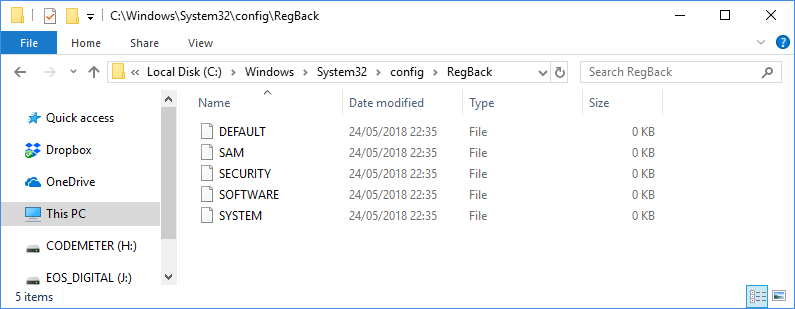How to enable Windows 10 registry for backups
The automatic backups of the Windows 10 registry were disabled without notice as of version 1803. Given the stability problem of the next version, the autumn version, this made think that another error is working in the system. This was not the case.
Microsoft has subsequently explained the change and applies to all SKUs of Windows 10 version 1803, 1809 and 1903, including versions Home, Pro, Education and Enterprise: “From Windows 10 version 1803, Windows no longer automatically makes a backup of the system registry in the RegBack folder. If you navigate to the Windows folder System32 config RegBack in Windows Explorer, you will still see the registry sections, but each file has a size of 0 Kb.
Concreting. The function is disabled by default, but not deleted. Although Microsoft recommends to the users to use in its defect the function of point of restoration of the system, the user or administrator who wishes it can restore this characteristic.
How to enable Windows 10 registry backups
As always that we act in the registry, you must previously make a manual copy of it or create a system restore point in case something fails in the process. Once done, we follow this step by step:
- Access the registry with the shortcut keys “Windows + R”, command “regedit”.

- Go to the path “Team\HKEY_LOCAL_MACHINE\SYSTEM\CurrentControlSet\Control\Session Manager\Configuration Manager”.
- Right-click to create a new DWORD key (32-bit)

- Set the name “EnablePeriodicBackup” and “1” in value data.

- Click OK and restart the system
From here “Windows will back up the registry to the RegBack folder when the computer restarts and create a RegIdleBackup task to manage subsequent backups. Windows stores the task information in the Scheduled Tasks Library, in the Microsoft \ Windows \ Registry folder,” Microsoft explains.
To make sure we’ve completed the process correctly and that the automatic Windows 10 registry backups are running, check the following:
- Opens the system task scheduler.

- Navigate to the path Library > Microsoft > Windows > Registry.
- Make sure the “RegIdleBackup” task is working. If it is not activated, right-click on it and run it.

All set. If you access the path C with the file explorer: \ Windows\ System32 \ config \ RegBack, you will see the copies made.

It is more difficult to explain the process than to do it, but we still don’t understand why Microsoft has disabled it by default when these Windows 10 registry backups are tremendously useful for advanced users and administrators. The reasons given for “space saving” are not sustained, considering that a typical backup of a client system has a size between 100 and 150 Mbytes.





















